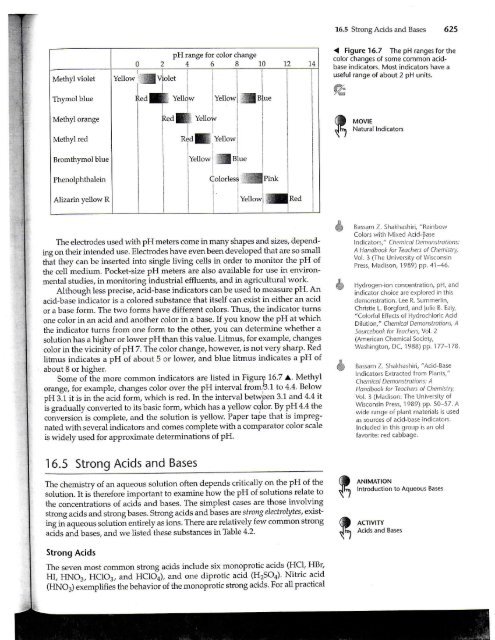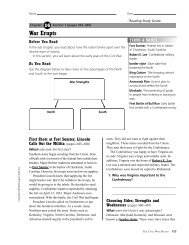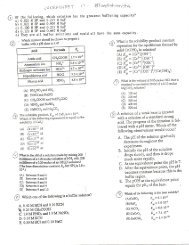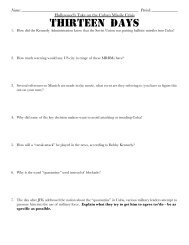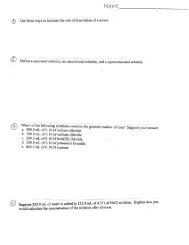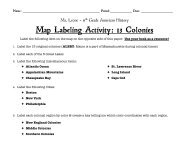Chapter 16 Text
Chapter 16 Text
Chapter 16 Text
Create successful ePaper yourself
Turn your PDF publications into a flip-book with our unique Google optimized e-Paper software.
<strong>16</strong>.5 Strong Acids and Bases 625<br />
Methyl violet<br />
Thymol blue<br />
Methyl orange<br />
Methyl red<br />
Bromthymol blue<br />
Phenolphthalein<br />
Alizarin yellow R<br />
pH range for color change<br />
•4 Figure <strong>16</strong>.7 The pH ranges for the<br />
color changes of some common acidbase<br />
indicators. Most indicators have a<br />
0 2 4 6 8 10 12 14<br />
Yellow :^|V olet<br />
useful range of about 2 pH units.<br />
^m [: Yellcw<br />
Yellow m* ue<br />
RedH |. Yelloiff<br />
MOVIE<br />
Natural Indicators<br />
Re*m<br />
Yellow<br />
Yellow :3B ue<br />
f<br />
"olorles :31Pink<br />
Yellow m Red<br />
The electrodes used with pH meters come in many shapes and sizes, depending<br />
on their intended use. Electrodes have even been developed that are so small<br />
that they can be inserted into single living cells in order to monitor the pH of<br />
the cell medium. Pocket-size pH meters are also available for use in environmental<br />
studies, in monitoring industrial effluents, and in agricultural work.<br />
Although less precise, acid-base indicators can be used to measure pH. An<br />
acid-base indicator is a colored substance that itself can exist in either an acid<br />
or a base form. The two forms have different colors. Thus, the indicator turns<br />
one color in an acid and another color in a base. If you know the pH at which<br />
the indicator turns from one form to the other, you can determine whether a<br />
solution has a higher or lower pH than this value. Litmus, for example, changes<br />
color in the vicinity of pH 7. The color change, however, is not very sharp. Red<br />
litmus indicates a pH of about 5 or lower, and blue litmus indicates a pH of<br />
about 8 or higher.<br />
Some of the more common indicators are listed in Figure <strong>16</strong>.7 A. Methyl<br />
orange, for example, changes color over the pH interval from.3.1 to 4.4. Below<br />
pH 3.1 it is in the acid form, which is red. In the interval between 3.1 and 4.4 it<br />
is gradually converted to its basic form, which has a yellow color. By pH 4.4 the<br />
conversion is complete, and the solution is yellow. Paper tape that is impregnated<br />
with several indicators and comes complete with a comparator color scale<br />
is widely used for approximate determinations of pH.<br />
Hydrogen-ion concentration, pH, and<br />
indicator choice are explored in this<br />
demonstration. Lee R. Summerlin,<br />
Christie L. Borgford, and Julie B. Ealy,<br />
"Colorful Effects of Hydrochloric Acid<br />
Dilution," Chemical Demonstrations, A<br />
Sourcebook for Teachers, Vol. 2<br />
(American Chemical Society,<br />
Washington, DC, 1988) pp. 177-178.<br />
Bassam Z. Shakhashiri, "Acid-Base<br />
Indicators Extracted from Plants,"<br />
Chemical Demonstrations: A<br />
Handbook for Teachers of Chemistry,<br />
Vol. 3 (Madison: The University of<br />
Wisconsin Press, 1989) pp. 50-57. A<br />
wide range of plant materials is used<br />
as sources of acid-base indicators.<br />
Included in this group is an old<br />
favorite: red cabbage.<br />
<strong>16</strong>.5 Strong Acids and Bases<br />
The chemistry of an aqueous solution often depends critically on the pH of the<br />
solution. It is therefore important to examine how the pH of solutions relate to<br />
the concentrations of acids and bases. The simplest cases are those involving<br />
strong acids and strong bases. Strong acids and bases are strong electrolytes, existing<br />
in aqueous solution entirely as ions. There are relatively few common strong<br />
acids and bases, and we listed these substances in Table 4.2.<br />
ANIMATION<br />
Introduction to Aqueous Bases<br />
ACTIVITY<br />
Acids and Bases<br />
Strong Acids<br />
The seven most common strong acids include six monoprotic acids (HC1, HBr,<br />
HI, HNO3, HC1O3, and HC1O4), and one diprotic acid (H2SO4). Nitric acid<br />
(HNO3) exemplifies the behavior of the monoprotic strong acids. For all practical


